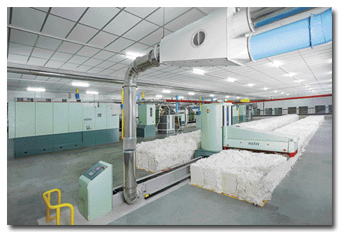This is the last in a series of exhibitor previews leading up to ITMA 2011, which will open this
week in Barcelona, Spain. As everybody knows, Italy is one of the major players supplying textile
machinery to the world. In this issue, the Rupp Report pays respects to one of the well-known
Italian companies, Savio Macchine Tessili S.p.A. in Pordenone. For exactly 100 years, since its
founding in 1911, Savio has played an important role. The Rupp Report talked to Paolo Puntoni,
Savio’s marketing manager.
Today, Savio — as a member of the Italy-based Itema Group — comprises the Itema Spinning
business unit. In addition to the production site in Pordenone, Savio also operates daughter
companies including production sites in China — Savio (Shandong) Textile Machinery Co. Ltd. — and
India — Savio India Ltd. The company specializes in yarn-forming machinery including automatic
winders, two-for-one twisters and open-end rotor spinning frames.
Asian Market In The Foreground
Savio exports 95 percent of all the machinery it produces. “At the moment, China and India
are our most important export countries,” Puntoni said. These countries are customers for Savio’s
current top sellers, the manual winders Orion/M and Polar/M. “The Far East markets are still
requesting manual machines, even as there is increasing demand for fully automatic machines also in
the emerging markets, mainly to overcome the shortage of labor,” he added.
“After a period of rapid market reduction — which occurred in 2008 and the first half of 2009
due to a global financial crisis that has affected all manufacturing sectors — in the second half
of 2009, there has been a good market recovery, which lasted throughout 2010 and reached record
levels in the first half of 2011,” Puntoni continued.
According to Puntoni, the markets have been booming, thanks to the increased domestic demand
in several countries, especially in the Far East. However, from the second half of 2011, the market
has been moving toward lower levels, adjusting to market trends.
“For the time being,” Puntoni mentioned, “the market trend is still satisfactory after a boom
in the first part of the year 2011. And, of course, the current volatile currency situation is
influencing our business, because the majority of our sales are influenced by the euro/U.S. dollar
exchange situation.” And what are currently the most important market requirements for Savio’s
products? “Oh, this is quite clear,” he explained. “Our customers want machines that give value for
the money spent.”
ITMA Barcelona
Some 50 people will be present at the Savio booth at ITMA in Barcelona. The company invited
customers through its worldwide network of agencies. Great attendance is Puntoni’s expectation for
ITMA 2011.
The Future
Taking a look into the crystal ball, what are the targets of Savio for the next two years?
“We foresee a consolidation in the market,” Puntoni said. And how is Savio facing these challenges?
“We must be present to market trends with permanent technology developments. And for the coming
years we expect a repositioning of the market level for 2012,” he said.
September 20, 2011






